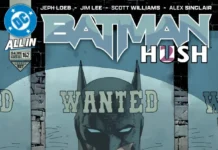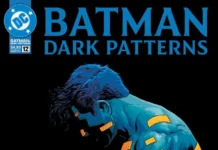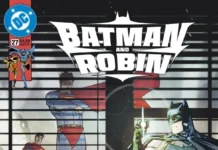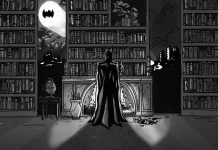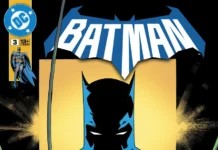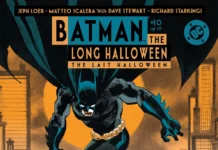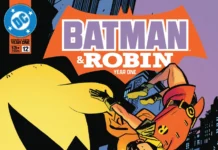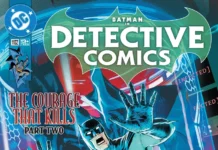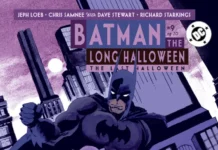FLASHPOINT BATMAN: KNIGHT OF VENGEANCE Retrospective
 Company-wide crossover events are just about as sure a thing you can run into in the realm of reading comics as dying or paying taxes in the real world. While comic book publishers often tout the forthcoming crossover to be an “earth-shattering” event that readers simply cannot miss, the truth is that more often than not, while often having memorable moments, a lot of these stories simply don’t stand the test of time without the immediacy and the full marketing machine backing them up in the moment.
Company-wide crossover events are just about as sure a thing you can run into in the realm of reading comics as dying or paying taxes in the real world. While comic book publishers often tout the forthcoming crossover to be an “earth-shattering” event that readers simply cannot miss, the truth is that more often than not, while often having memorable moments, a lot of these stories simply don’t stand the test of time without the immediacy and the full marketing machine backing them up in the moment.
Every rule has its exceptions, of course. Marvel’s Secret Wars or DC’s Crisis on Infinite Earths are the two most prototypical examples of a crossover, and other more recent event behemoths like 2004’s Identity Crisis from DC or 2006’s Civil War from Marvel come to mind.
But when it comes to other events, do you remember them? Remember The Final Night? Decimation? The Messiah Complex? Fear Itself? Our Worlds at War? Genesis? Unless you’re a longtime comics reader, you probably haven’t heard of these kinds of stories, much less read them. Or, maybe you are familiar with them because other stories have referred to them, but you…haven’t read them.
The point, of course, is that comic book crossover events are a dime a dozen (Convergence or Shadowland), and only the real cream manages to rise to the top (House of M or Doomsday Clock, come at me).
But…what about Flashpoint?
2011’s eponymous company-wide story spinning out of Geoff Johns’ second major run on The Flash was, in many ways, the prototypical comic book event. It had its own pretty good 5-issue core mini-series, and a whole plethora of tie-in series and single issues that ranged from pretty forgettable (Green Lantern: Abin Sur) to legitimately interesting (Project: Superman) in the whole stack of tie-in issues to this event, you’d be forgiven for seeing one, even one featuring your favorite character, and thinking it would be, at best, unremarkable.
It’s very strange, then, that a 3-issue tie-in mini-series is not only remembered alongside the event that spawned it, but may actually be revered more than the core series it was attached to.
This describes Brian Azzarello’s and Eduardo Risso’s Flashpoint Batman: Knight of Vengeance in a reasonably accurate way.
Azzarello at this point is already a well-established creator with a whole library of extremely interesting, dark and complex stories under his proverbial belt. Not only did he and artist Risso create an acclaimed mature Vertigo Comics series called 100 Bullets, but the team’s Batman bonafides were well-established since they had the unenviable task of following the work of Jeph Loeb and Jim Lee on the original Hush story in the main Batman title in 2004 for a story called Broken City.
I was actually the writer fortunate enough to review the single issues of Flashpoint Batman for BOF while it was coming out in the summer of 2011, and was knocked on my proverbial ass three consecutive times for each issue. At the time, I was also reviewing the main Flashpoint title for BOF, and compared the two of them this way in my review for Flashpoint Batman #2:
“I’ve said in reviews for the main [Flashpoint] series how the vibrancy in both color and action is reminiscent of the Silver Age of comics. By contrast, Batman: Knight of Vengeance, while very well-rendered by Eduardo Risso, feels as black as night when comparing the two. The creative team really analyzes the psyche of this Batman, haunted by the death of his son, who goes out every night and beats the living hell out of criminals, playing largely by their rules.”
Comparing the two stories as “night and day” is just as apt in 2019 as it was in 2011.
At the conclusion of the main series’ first issue, we learned that the Batman of the Flashpoint version of the DC Universe is actually Thomas Wayne, the father of Bruce and the husband of Martha. Not only is this universe different by making Bruce the only victim of Joe Chill instead of his parents, but that tragedy that drives Thomas to become a brutal, harder-edged Batman also takes a serious toll on Martha Wayne. So serious, in fact, that she becomes the Flashpoint world’s Joker.

The moody art style and deco design of the layouts give life to a Gotham City that is, if you can believe it, seemingly more corrupt than ever, and someone profiting off the vices of others through a popular casino is…Thomas Wayne, who employs a security chief by the name of Oswald Cobblepot. The casino’s gains help fund Batman’s war on crime; a comparatively bloody, gruesome and often deadly affair when compared to the methods of Bruce Wayne in the unaltered DC Universe.
What Knight of Vengeance offers us is an askew look at how the mantle of the Batman can be contorted and strained, in true Elseworlds fashion even if the series doesn’t strictly sit within the framework of that imprint’s rules.
Interestingly, Knight of Vengeance also takes place in part during the main Flashpoint title, where Thomas discovers how that fateful night in Crime Alley should’ve transpired: with Bruce alive, and with him and Martha dead. It creates an extremely interesting character dynamic for Thomas who, we now realize, enthusiastically fights for the chance to save his son even knowing the despair and the ultimate mission that will come from the necessity of his own death.
Aesthetically and even character-wise, it’s clear that Azzarello and Risso took more than a few lessons from another popular story of an older Batman fighting in a world that seems to become crazier by the day, Frank Miller’s The Dark Knight Returns. Because this Batman is not Bruce Wayne, though, Knight of Vengeance is a story that feels heavily rooted to existing Batman mythology while also showing us that “Darker” Knight without compromising the integrity of the longstanding, iconic vision of comic book Batman.
Overall, the Flashpoint event — while certainly foundational to the lore of the current DC Universe — may eventually fade into obscurity if not for this one, stellar tie-in series. It’s become even more important in the wider context of writer Tom King’s current run on Batman, demonstrating not only the Flashpoint Batman’s surprising longevity but also the smart, layered character work of the Knight of Vengeance series.
This one-off story may seem like a blip on the radar of comic book history. However, engaging artwork and a darkly complex main character fighting for the last glimpse of hope that exists in a compromised world makes Flashpoint: Batman – Knight of Vengeance well worth any Bat-fan’s time.
Come for the twisted, contorted universe. Stay for the grim and compelling older, grittier bastard of a Dark Knight. – Chris Clow

